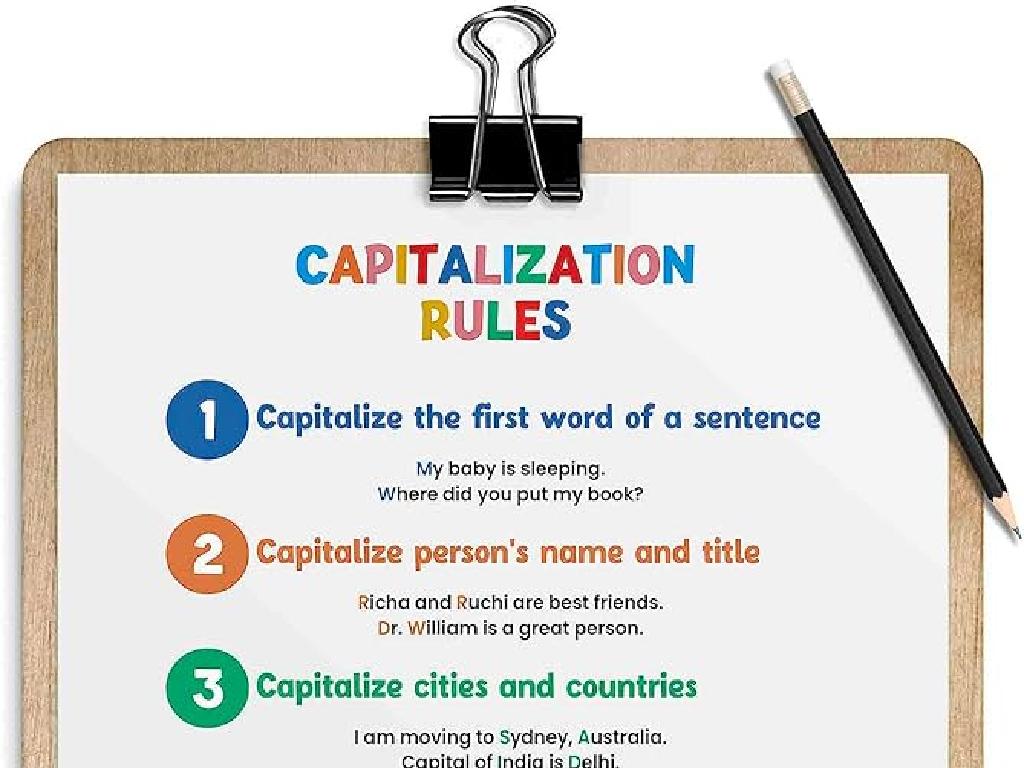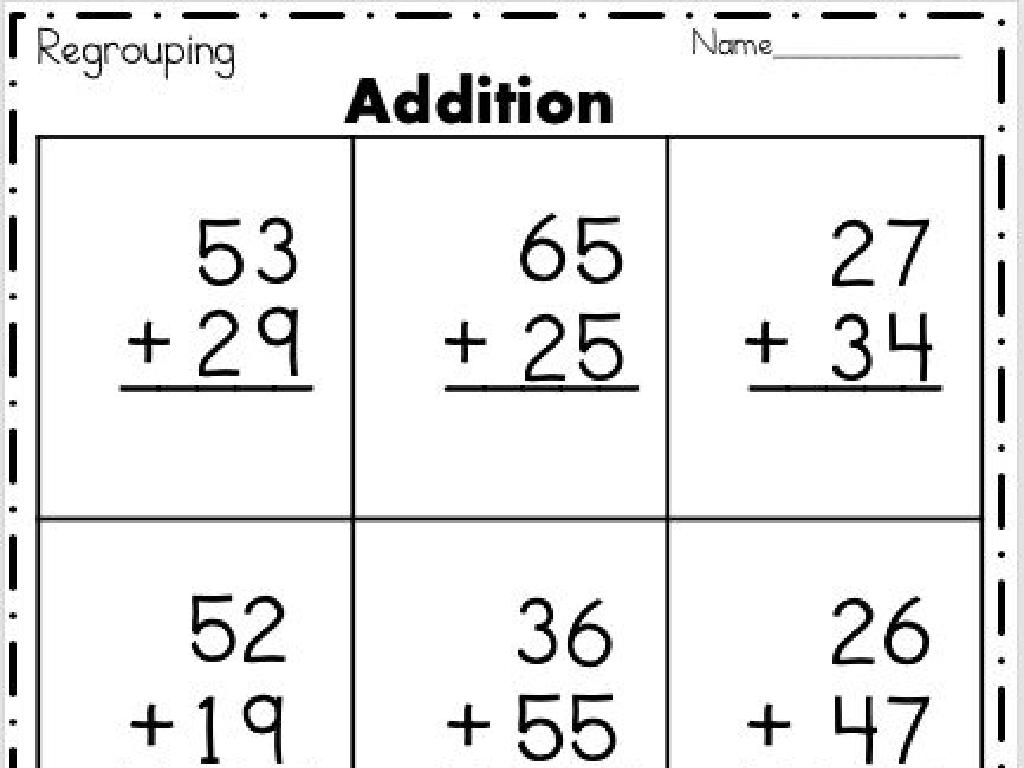Use Data From Tests To Compare Engineering-Design Solutions
Subject: Science
Grade: Eighth grade
Topic: Engineering Practices
Please LOG IN to download the presentation. Access is available to registered users only.
View More Content
Introduction to Engineering Practices
– Understanding the role of engineering
– Engineering shapes our world by solving problems.
– Comparing engineering-design solutions
– We’ll learn how to evaluate different designs.
– Using data to analyze solutions
– Data helps us objectively decide which design is most effective.
– Learning objective: Best solutions
|
This slide introduces students to the fundamental concepts of engineering and its significance in the modern world. Emphasize the importance of engineering in creating solutions to everyday problems and how it has led to technological advancements. Today’s focus is on comparing different engineering-design solutions by using data from tests. This analytical approach is crucial for determining the most effective design. The learning objective is to equip students with the skills to use data to analyze and determine the best engineering solutions. Encourage students to think critically about how data can inform decisions and improve designs. Provide examples of how engineers use data in real-world scenarios to enhance their understanding.
Understanding Engineering and Design
– Define engineering
– Application of science and math to solve problems
– Steps of the Engineering Design Process
– Identify problem, develop solutions, select best, build prototype, test, improve, share
– Testing and evaluating prototypes
– Collect data from tests to determine effectiveness
– Iterative improvement and communication
– Refine design based on test data and share findings
|
This slide introduces students to the concept of engineering and the engineering design process. Engineering is defined as the application of scientific and mathematical principles to create solutions to problems. The design process is a series of steps that engineers use to come up with a solution, including identifying a problem, brainstorming possible solutions, and then developing, testing, and improving a prototype. Emphasize the importance of testing and evaluating prototypes to compare different design solutions. Highlight that engineering is an iterative process, where improvements are made based on test results, and successful solutions are shared with the community. Encourage students to think of examples where they have used a similar process to solve problems.
The Importance of Testing in Engineering
– Why testing is essential
– Ensures designs meet requirements and are safe
– Various engineering tests
– Stress, usability, performance tests check different aspects
– Gathering test data
– Collect data systematically for accuracy
– Analyzing test results
– Use statistical methods to interpret data
|
Testing is a critical step in the engineering design process as it validates the functionality, safety, and reliability of a design before full-scale production or implementation. Stress tests evaluate the strength of materials, usability tests ensure the product meets user needs, and performance tests measure operational efficiency. Accurate data collection is vital for meaningful analysis. Teach students how to organize data in tables or charts and to use statistical tools to compare different design solutions. Emphasize the importance of iterative testing and refinement to achieve the best engineering outcomes.
Comparing Engineering Design Solutions
– Steps to compare designs
– Gather data, define criteria, evaluate each design
– Criteria for comparison
– Consider cost, efficiency, sustainability, aesthetics
– Analyzing bridge design examples
– Compare two bridge designs using specific test results
– Importance of test data
|
This slide aims to guide students through the process of comparing different engineering designs by using a structured approach. Start by explaining the importance of gathering relevant data and defining clear comparison criteria. Discuss how cost, efficiency, sustainability, and aesthetics play a crucial role in determining the superiority of one design over another. Use the example of comparing two bridge designs to illustrate how test data can provide insights into which design performs better under certain conditions. Emphasize the value of empirical evidence in making informed decisions in engineering. Encourage students to think critically about the trade-offs involved in design choices.
Case Study: Bridge Design Solutions
– Explore bridge engineering basics
– Introduction to types and functions of bridges
– Overview of two bridge designs
– Compare suspension bridge vs. beam bridge designs
– Data collection in bridge testing
– Discuss methods like stress tests and load capacity
– Comparing design solutions
|
This slide introduces students to the field of bridge engineering and sets the stage for a case study comparing two different bridge design solutions. Begin with a brief overview of bridge engineering, including the purpose and types of bridges. Then, present an overview of the two bridge designs that will be the focus of the case study: a suspension bridge and a beam bridge. Explain the importance of data collection methods such as stress tests, which measure a bridge’s ability to withstand pressure, and load capacity tests, which determine how much weight a bridge can support. The goal is to understand how engineers use data from these tests to compare and improve design solutions. Encourage students to think critically about how different designs might serve different purposes based on the data collected.
Analyzing Engineering Case Study: Bridge Design
– Review bridge test data
– Examine data for load capacity, materials used, and cost efficiency
– Interpret test results
– Analyze what the numbers indicate about each bridge’s performance
– Discuss superior design
– Compare designs based on data and decide on the best one
– Justify design choices
– Use evidence from data to support which bridge design is most effective
|
This slide is aimed at engaging students in the practical application of data analysis in engineering. Begin by reviewing the data collected from different bridge tests, focusing on key performance indicators such as load capacity, materials used, and cost. Guide students to interpret the data to understand what it reveals about the performance and efficiency of each bridge design. Facilitate a group discussion where students can debate which design is superior based on the data, encouraging them to use critical thinking and evidence-based reasoning. The goal is for students to practice justifying their choices using real-world data, a crucial skill in engineering design and decision-making processes.
Making Informed Decisions in Engineering
– Utilize data for engineering choices
– Data guides decisions on materials, cost, and efficiency
– Understand trade-offs and optimization
– Balancing pros and cons for the most effective design
– Decision-making in design solutions
– Analyze data to choose the most suitable design for a problem
– Exercise: Best design selection
– Class activity: Evaluate different designs based on test data
|
This slide introduces the concept of using empirical data to make informed decisions in engineering. Emphasize the importance of data in evaluating materials, cost, and efficiency to determine the best design solutions. Discuss the concept of trade-offs, where certain aspects of a design may be sacrificed for the greater benefit of the overall project, and optimization, the process of making a design as effective as possible. The class activity involves students working in groups to select the best design solution for a given problem by analyzing provided data from tests. This exercise will help students understand the practical application of data in making engineering decisions and the importance of critical thinking in the design process.
Class Activity: Engineering Design Challenge
– Form small groups for design task
– Create and test your design solution
Consider constraints like materials, time, and design criteria
– Collect and record data from tests
Measure outcomes such as distance, speed, or strength
– Present findings and compare
Discuss what worked, what didn’t, and why
|
This activity is aimed at teaching students the practical aspects of engineering design and the importance of testing and data collection. Divide the class into small groups and assign them a problem to solve with a simple design. Provide a set of materials and criteria for the design. Once the groups have created their solutions, they will test them and gather data on their performance. After testing, each group will present their design, the data collected, and their conclusions. Encourage groups to compare their results and discuss different design approaches. Possible activities: 1) Building a bridge from paper and testing its strength. 2) Creating a parachute for an egg drop. 3) Designing a water filtration system. 4) Constructing a simple vehicle powered by a rubber band. 5) Assembling a catapult and measuring how far it can launch a projectile.
Conclusion: Engineering Practices & Data Analysis
– Recap: Engineering Practices
– Review of how engineers use practices to solve problems.
– Reflect on Design Comparison
– Discuss insights from today’s activity on design solutions.
– Homework: Reflective Essay
– Write an essay on the design process and data’s significance.
– Understanding Data’s Role
– Grasp why data is crucial in evaluating engineering solutions.
|
As we wrap up today’s lesson, it’s important to revisit the engineering practices we’ve learned and understand the pivotal role of data in comparing and refining design solutions. Encourage students to reflect on the activities they engaged in today, discussing what they learned about the process of comparing different engineering designs. For homework, students should write a reflective essay on the design process, emphasizing the importance of testing and data analysis in making informed decisions. This exercise will help solidify their understanding of the iterative nature of engineering and the critical evaluation of data to improve outcomes.






